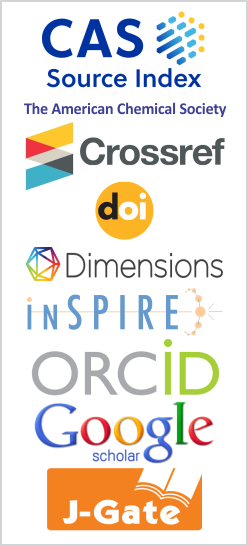Effect of Debye Plasma on Hydrogenic Photoionization Cross Section
DOI:
https://doi.org/10.26713/jamcnp.v2i2.321Abstract
In this work, we have studied the effect of plasma screening on the ground and excited state photoionization cross section \((\sigma)\) of hydrogenic system. We have considered weakly coupled plasma where the screening of nuclear charge by plasma free electrons is represented by Debye-Huckel potential. Using this potential, radial Schrodinger equation is solved numerically to obtain the bound and free state wave functions, and transition matrix elements. Adaptive step size controlled Runge-Kutta method is used for numerical integration. Use of adaptive method for grid generation ensures lesser computational time as compared to uniform grid system. Using the methodology, we have computed photoionization cross section from \(1s\) ground state and excited \(2p\) state of hydrogenic system. Strong enhancements in \(\sigma\) are observed which are generally termed as shape resonances. It is noted that these resonances occur for specific screening values where bound states are pressure ionized to enter the quasi-bound regime. The changes in the phase and amplitude of continuum wave functions also lead to appearance of Cooper minimum in \(\sigma\) of excited \(2s\) state. We have compared the results with existing theoretical and experimental data wherever they are available.Downloads
References
F. Anthony, Starace, photoionization of atoms, Research Papers in Physics and Astronomy, 1996.
J. J. Yeh and I. Lindau, Atomic subshell photoionization cross sections and asymmetry parameters: $1< Z< 103$, At. Data. & Nucl. Data. Tables., 32 (1985), 1–155.
D. Salzman, Atomic Physics in Hot Dense Plasma, New York: Oxford; 1998.
M. S. Murillo and J. C. Weisheit, Dense plasmas, screened interactions, and atomic ionization, Phys. Rep., 302 (1998), 1–65.
S. Atzeni and J. Meyer-ter-Vehn, The Physics of Inertial Fusion: Beam Plasma Interaction, Hydrodynamics, Hot Dense Matter, New York: Oxford University Press, 2004.
J. A. Kunc and W. H. Soon, Maximum principal quantum numbers of the atomic hydrogen in the solar chromosphere and photosphere, Astro. J., 396 (1992), 364–368.
N. Kryukov and E. Oks, Ionization channel of continuum lowering in plasmas: effects of plasma screening, electric and magnetic fields, J. Phys. B: At. Mol. Opt. Phys., 46 (2013), 245701-245701-10.
M. W. C. Dharma-wardana, Level shifts, continuum lowering, and the mobility edge in dense plasmas, Phys. Rev. A, 45 (1992), 5883-5896.
H. R. Griem, Principles of Plasma Spectroscopy, Cambridge: Cambridge University Press, 1997.
John C. Stewart and Kedar D. Pyatt, Lowering of ionization potentials in plasma, Astrophysical J., 144 (1966), 1203-1211.
G. Chiu and A. Ng, Pressure ionization in dense plasmas, Phys. Rev. E, 59 (1999), 1024-1032.
R. M. More, Pressure ionization, resonances, and the continuity of bound and free states, Adv. At. Mol. Phys., 21 (1985), 305-356.
M. Nantel, G. Ma and S. Gu et al., Pressure ionization and line merging in strongly coupled plasmas produced by 100-fs laser pulses, Phys. Rev. Lett., 80 (1998), 4442-4445.
G. B. Zimmerman and R. M. More, Pressure ionization in laser-fusion target simulation, J. Quant. Spectrosc. Radiat. Transfer, 23 (1980), 517-522.
V. E. Fortov, V. Ya. Ternovo and M. V. Zhernokletov et al., Pressure-produced ionization of nonideal plasma in a megabar range of dynamic pressures, J. Expt. Th. Phys., 97 (2003), 259–278.
Y. Jung, Plasma screening effects on photoionizations in weakly coupled plasmas, Phys. Plasma, 5 (1998), 3781.
Y. Y. Qi, J. G. Wang and R. K. Janev, Dynamics of photoionization of hydrogen like ions in Debye plasmas, Phy. Rev. A, 80 (2009), 063404.
C. Y. Lin and Y. K. Ho, Effects of screened coulomb abd exponential cosine-screened Coulomb potentials on photoionization of H and Heí…, Eur. Phys. J. D, 57 (2010), 21.
T. Utsumi and J. Koga, Accurate numerical method for the solutions of the Schrödinger equation and the radial integrals based on the CIP method, Comp. Phy. Comm., 148 (2002), 267-280.
S. T. Manson, Topics in Appl. Phys. 26 (1978), 135.
A. Burgess and M. J. Seaton, A general formula for the calculation of atomic photo-ionization cross sections, Monthly Notices of the Royal Astronomical Society, 120 (1960), 121-151.
B. H. bransden and C. J. Joachain, Physics of Atoms and Molecules, Singapore: Pearson Education, 2004.
http://physics.nist.gov/cgi-bin/ASD/energy1.pl
B. Saha, P. K. Mukherjee and G. H. F. Diercksen, Energy levels and structural properties of compressed hydrogen atom under Debye screening, Astronomy and Astrophysics, 396 (2002), 337-344 .
H. R. Sadeghpour, J. L. Bohn and M. J. Cavagnero et al. Collisions near threshold in atomic and molecular physics, J. Phys. B: At. Mol. Opt. Phys., 33 (2000), R93-R140.
M. Bylicki, A. Stachow, J. Karwowski and P. K. Mukherjee, The resonance levels of the Yukawa potential, Chem. Phys., 331 (2007), 346-350.
M. Das, Effect of strongly coupled plasma on photoionization cross section, Phys. Plasmas, 21 (2014), 012709.
C. Y. Lin and Y. K. Ho, Influence of Debye plasma on photoionization of Li-like ions: Emergence of Cooper minimum, Phys. Rev. A, 81 (2010), 033405.
Downloads
Published
How to Cite
Issue
Section
License
Authors who publish with this journal agree to the following terms:- Authors retain copyright and grant the journal right of first publication with the work simultaneously licensed under a CCAL that allows others to share the work with an acknowledgement of the work's authorship and initial publication in this journal.
- Authors are able to enter into separate, additional contractual arrangements for the non-exclusive distribution of the journal's published version of the work (e.g., post it to an institutional repository or publish it in a book), with an acknowledgement of its initial publication in this journal.
- Authors are permitted and encouraged to post their work online (e.g., in institutional repositories or on their website) prior to and during the submission process, as it can lead to productive exchanges, as well as earlier and greater citation of published work.




